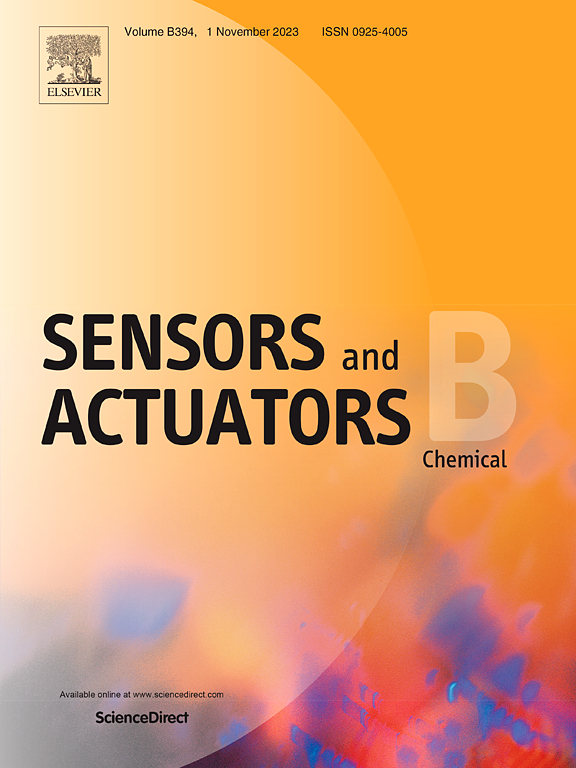A novel fluorescent sensing strategy for point-of-care monitoring of Hg2 +-induced oxidative stress in HeLa cells, zebrafish and mice models
IF 8
1区 化学
Q1 CHEMISTRY, ANALYTICAL
引用次数: 0
Abstract
Hg2+-induced oxidative stress is an important pathway mediating biotoxicity, and the dynamics of reactive oxygen/nitrogen species (ROS/RNS) is a key indicator for quantitatively assessing the level of oxidative stress. Herein, a novel “targeted dual recognition” NIR fluorescent chemosensor (DDPT) was constructed for the specific recognition of Hg2+ and ONOO-. The DDPT activated by Hg2+ for the detection of ONOO- exhibited rapid response (<50 s), high sensitivity (16.8 nM) and excellent selectivity. The P = S bond in DDPT is oxidized to P = O by Hg2+, followed by ONOO- the specific attack on the P-O bond to break it, releasing the DDPT-OH to generate a significant fluorescence enhancement (with a Stokes shift up to 188 nm). The response mechanism of DDPT was systematically verified by 1HNMR, HRMS and DFT theoretical calculations. Furthermore, DDPT was successfully evaluated for imaging Hg2+-induced ONOO- dynamics in cellular, zebrafish and mouse models due to its advantages of low cytotoxicity, high tissue permeability and biocompatibility. The results reveal that Hg2+ induces oxidative stress and increases ONOO- concentration to destroy the antioxidant defense system of organisms, thus triggering the toxic pathway of oxidative stress. The development of DDPT provides a basis for analyzing pollutant-oxidative stress interactions, assessing health risks, and developing targeted intervention strategies.
一种新的荧光传感策略,用于即时监测Hg2+诱导的HeLa细胞、斑马鱼和小鼠模型中的氧化应激
Hg2+诱导的氧化应激是介导生物毒性的重要途径,活性氧/氮物种(reactive oxygen/nitrogen species, ROS/RNS)的动态变化是定量评估氧化应激水平的关键指标。本文构建了一种新型的“靶向双识别”近红外荧光化学传感器(DDPT),用于特异性识别Hg2+和ONOO-。Hg2+激活的DDPT检测ONOO-具有快速响应(50 s)、高灵敏度(16.8 nM)和良好的选择性。DDPT中的P=S键被Hg2+氧化为P=O,随后ONOO-对P-O键的特异性攻击使其断裂,释放出DDPT- oh,产生显著的荧光增强(Stokes位移高达188 nm)。通过1HNMR、HRMS和DFT理论计算,系统验证了DDPT的响应机理。此外,由于DDPT具有低细胞毒性、高组织渗透性和生物相容性的优点,我们成功地在细胞、斑马鱼和小鼠模型中对Hg2+诱导的ONOO-动力学进行了成像评估。结果表明,Hg2+诱导氧化应激,使ONOO-浓度升高,破坏机体的抗氧化防御系统,从而触发氧化应激的毒性途径。DDPT的发展为分析污染物-氧化应激相互作用、评估健康风险和制定有针对性的干预策略提供了基础。
本文章由计算机程序翻译,如有差异,请以英文原文为准。
求助全文
约1分钟内获得全文
求助全文
来源期刊

Sensors and Actuators B: Chemical
工程技术-电化学
CiteScore
14.60
自引率
11.90%
发文量
1776
审稿时长
3.2 months
期刊介绍:
Sensors & Actuators, B: Chemical is an international journal focused on the research and development of chemical transducers. It covers chemical sensors and biosensors, chemical actuators, and analytical microsystems. The journal is interdisciplinary, aiming to publish original works showcasing substantial advancements beyond the current state of the art in these fields, with practical applicability to solving meaningful analytical problems. Review articles are accepted by invitation from an Editor of the journal.
 求助内容:
求助内容: 应助结果提醒方式:
应助结果提醒方式:


